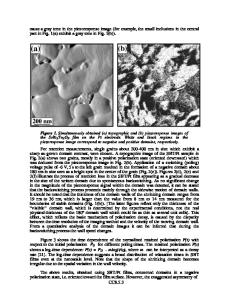Low-temperature crystallization induced by excimer laser irradiation of SrBi 2 Ta 2 O 9 films
- PDF / 83,929 Bytes
- 4 Pages / 612 x 792 pts (letter) Page_size
- 31 Downloads / 334 Views
Hironao Hiramatsu and Yoshimichi Ohkia),b) Department of Electrical, Electronics, and Computer Engineering, Waseda University, Shinjuku-ku, Tokyo 169-8555, Japan
In-Hoon Choi Division of Materials Science and Engineering, Korea University, 5-1 Anam-dong, Sungbuku-ku, Seoul 136-701, Korea
Yong-Tea Kim KIST, P.O. Box 131, Cheongryang, Seoul 130-650, Korea (Received 27 December 2000; accepted 9 April 2001)
Transition of a SrBi2Ta2O9 precursor film from amorphous to crystalline was induced by excimer laser irradiation. Both fluorite and perovskite crystalline structures in such films were obtained by excimer laser irradiation at substrate temperatures between 200 and 500 °C. Either an addition of excess bismuth in the precursor film or an increase in the substrate temperature enhanced the formation of the perovskite structure in the excimer laser-induced annealing process, resulting in the perovskite crystalline phase at a relatively lower temperature of 500 °C. Such a low temperature is preferred when SrBi2Ta2O9 is used in ferroelectric devices. The mechanism involved in this laser-induced crystallization is also discussed.
Layered perovskite oxides of strontium bismuth tantalate, SrBi2Ta2O9 (SBT), have been attracting much attention as a ferroelectric material due to their application in nonvolatile ferroelectric random access memory (FeRAM). Thin SBT films have superior endurance properties and small coercive fields after crystallization at high temperatures of 700–800 °C.1,2 However, such a high crystallization temperature might cause serious problems when SBT is used in Si-based ultra-large-scaleintegration processes.3 Therefore, a method to lower the crystallization temperature is needed in the field of FeRAM fabrication.4 Recently, we reported that ultraviolet laser irradiation significantly lowers the crystallization temperature of SBT, even though the obtained crystalline structure was a fluorite phase that is inappropriate to the FeRAM applications.5 In the present article, we report the laserinduced crystallization of the SBT to the perovskite structure and discuss its mechanism.
a)
Advanced Research Institute for Science and Engineering, Waseda University, Shinjuku-ku, Tokyo, 169-8555, Japan b) e-mail: [email protected] J. Mater. Res., Vol. 16, No. 7, Jul 2001
Commercial solutions of SBT for enhanced metalorganic deposition were spin-coated on a p-type Si substrate and then dried at 250 °C for 20 min in air. The process of coating and drying was repeated four times so that a 300-nm-thick amorphous SBT film was deposited. The effect of excess bismuth in the deposition solution on the crystallization of SBT was studied by using three solutions of different bismuth composition with respective Sr:Bi:Ta atomic ratios of 0.8:2.2:2.0, 0.8.2.6:2.0, and 0.8:3.0:2.0. The resulting films were exposed to intense ultraviolet photons from a KrF excimer laser during simultaneous thermal annealing in an infrared heating furnace. The pulse width and the pulse frequency of the excimer laser were 20–30 ns and 10 Hz
Data Loading...











